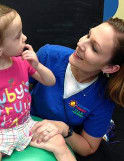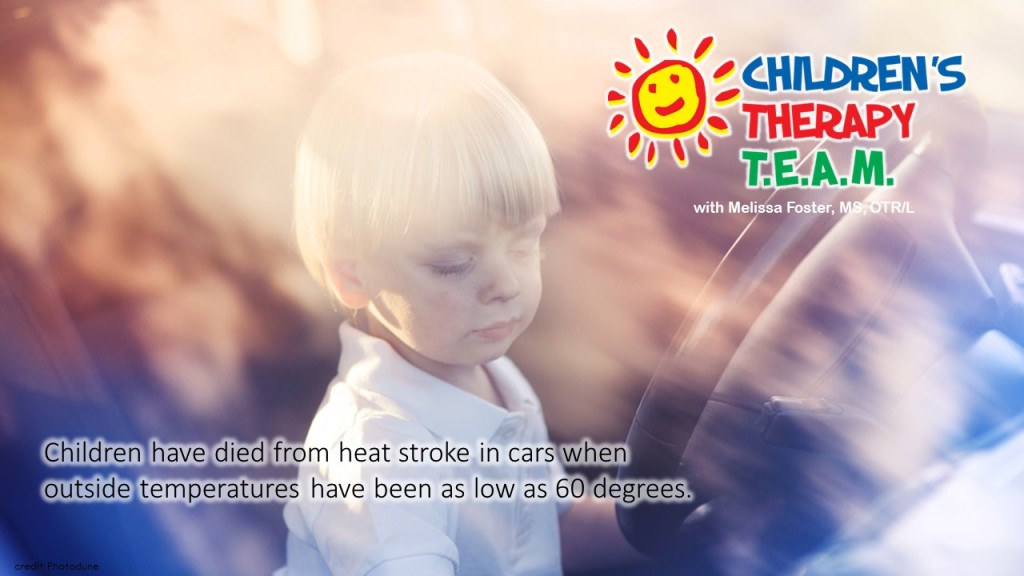Just as with the Drowning Risks and Prevention blog, this week's blog will be a bit more of a public service announcement as opposed to answering an actual parent question. As the mercury keeps rising on these summer days, I notice how hot my car is every afternoon when I get off work. Every time I get in my hot car, I remember that chilling YouTube video entitled One Decision that went viral in 2013. The video depicting how loving parents can easily get distracted, and how it can create disastrous results.
Statistics on Vehicular Heat Stroke
According to the non-profit safety group KidsAndCars.org, on average, 37 children die each year from heat-related deaths after being trapped inside a car. In addition, from 1990-2015, there were 755 children who died as a result of vehicular heat stroke. This can happen when a child is forgotten and left unattended in a hot car, a parent intentionally left the child in the car while he/she ran a “quick” errand, or because a child climbed into an unlocked car and became trapped in it. Within minutes, the danger can be real.
Why is it so dangerous to leave a child in a car?
Two words: “Greenhouse Effect." According to KidsAndCars.org, the inside of a vehicle heats up extremely quickly.
- The inside temperature can reach 125 degrees in just minutes, with 80% of the increase in temperature happening within the first 10 minutes. Therefore, purposefully leaving a child in the car while you “run in real quick” is NEVER a safe choice.
- Cracking the window does very little to slow down the heating process or to decrease the overall maximum temperature.
- Children have died from vehicular heat stroke when outside temperatures have been as low as 60 degrees.
Why are infants and toddlers more susceptible to heat-related deaths?
- A young child’s body overheats 3-5 times faster than an adult body.
- Even loving, caring parents are often distracted by changes in routine, lack of sleep, hormone changes, juggling multiple responsibilities, etc., which makes them even more likely to accidentally leave a child in the car.
- Rear-facing seats look the same whether there is a baby in them or not. When babies fall asleep in this rear-facing position, it is easy to forget that they are back there.
- The vast majority of children who have died from vehicular heat stroke (87%) have been age 3 years or younger, and 55% of vehicular heat stroke deaths involve children under the age of 24 months.
- In the majority of child vehicular heatstroke cases (55%), it was a loving, responsible parent who unknowingly left the child in the car resulting in a total of 413 fatalities from 1990-2015. (www.KidsAndCars.
org)
Tips to avoid child vehicular heat stroke (from WebMD)
- Never leave a child in a car. It doesn't matter how brief the time period is. As stated earlier, the largest increase in temperature occurs in the first 10 minutes, so just making a “quick trip inside” is never safe.
- Place a valuable item in the back seat. In researching many websites for this blog, several suggestions for this “valuable in the back seat” have included:
- Your left shoe
- Purse/wallet
- Cell phone - which provides the added safety bonus of no texting while driving!
- Keys for push button start cars – my car gives me an alarm if I am about to lock the keys in the car
- Get involved if you are a bystander. The National Highway Traffic Safety Administration advises bystanders tocall 911 immediately if they spy a child alone in a hot vehicle.
- Prevent kids from wandering into the car. Lock you car when you leave. Educate children to never play in the car, and keep your keys out of reach. Many children want to “drive like mommy or daddy," so they will want to get inside the car to pretend play. Unfortunately, they can also become accidentally locked in the car with disastrous consequences.
- If a child does become missing, always check the car first. Once again, the car is an attractive but dangerous play area, where the stakes can become very high very quickly. If you notice your little is missing, always check nearby vehicles first.
Want more information on how to keep your children safe around cars? Follow the links below:
Heat Stroke, KidsandCars.org, (accessed June 2016)
Dangers of Heatstroke, KidsandCars.org, (accessed June 2016)
Danger: Kids Left in Hot Cars. WebMD, (accessed June 2016)
Heat Stroke, KidsandCars.org, (accessed June 2016)
Dangers of Heatstroke, KidsandCars.org, (accessed June 2016)
Danger: Kids Left in Hot Cars. WebMD, (accessed June 2016)
About the Author:
 Melissa Foster is the leading contributor to Children’s Therapy TEAM’s Weekly Blog. She is a Pediatric Occupational Therapist with over a decade of experience in the field. An active public advocate in the NWA community, Melissa addresses topics related to Autism, Sensory Processing Disorder and general health and child development.
Melissa Foster is the leading contributor to Children’s Therapy TEAM’s Weekly Blog. She is a Pediatric Occupational Therapist with over a decade of experience in the field. An active public advocate in the NWA community, Melissa addresses topics related to Autism, Sensory Processing Disorder and general health and child development.
 Melissa Foster is the leading contributor to Children’s Therapy TEAM’s Weekly Blog. She is a Pediatric Occupational Therapist with over a decade of experience in the field. An active public advocate in the NWA community, Melissa addresses topics related to Autism, Sensory Processing Disorder and general health and child development.
Melissa Foster is the leading contributor to Children’s Therapy TEAM’s Weekly Blog. She is a Pediatric Occupational Therapist with over a decade of experience in the field. An active public advocate in the NWA community, Melissa addresses topics related to Autism, Sensory Processing Disorder and general health and child development.
